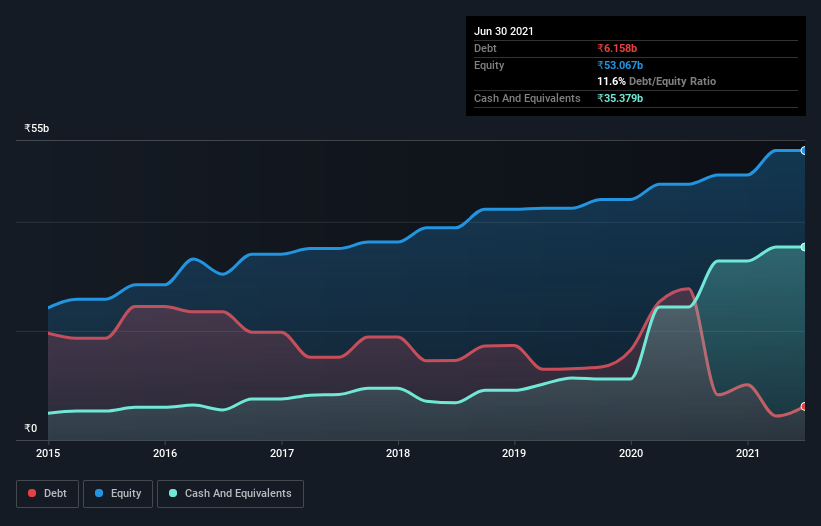- India
- /
- Electronic Equipment and Components
- /
- NSEI:REDINGTON
Does Redington (India) (NSE:REDINGTON) Have A Healthy Balance Sheet?

David Iben put it well when he said, 'Volatility is not a risk we care about. What we care about is avoiding the permanent loss of capital.' So it might be obvious that you need to consider debt, when you think about how risky any given stock is, because too much debt can sink a company. As with many other companies Redington (India) Limited (NSE:REDINGTON) makes use of debt. But is this debt a concern to shareholders?
When Is Debt Dangerous?
Debt is a tool to help businesses grow, but if a business is incapable of paying off its lenders, then it exists at their mercy. Part and parcel of capitalism is the process of 'creative destruction' where failed businesses are mercilessly liquidated by their bankers. However, a more common (but still painful) scenario is that it has to raise new equity capital at a low price, thus permanently diluting shareholders. Of course, plenty of companies use debt to fund growth, without any negative consequences. The first thing to do when considering how much debt a business uses is to look at its cash and debt together.
See our latest analysis for Redington (India)
How Much Debt Does Redington (India) Carry?
As you can see below, Redington (India) had ₹6.16b of debt at March 2021, down from ₹27.7b a year prior. But on the other hand it also has ₹35.4b in cash, leading to a ₹29.2b net cash position.

How Healthy Is Redington (India)'s Balance Sheet?
According to the last reported balance sheet, Redington (India) had liabilities of ₹89.9b due within 12 months, and liabilities of ₹2.63b due beyond 12 months. On the other hand, it had cash of ₹35.4b and ₹70.7b worth of receivables due within a year. So it can boast ₹13.6b more liquid assets than total liabilities.
This short term liquidity is a sign that Redington (India) could probably pay off its debt with ease, as its balance sheet is far from stretched. Succinctly put, Redington (India) boasts net cash, so it's fair to say it does not have a heavy debt load!
In addition to that, we're happy to report that Redington (India) has boosted its EBIT by 58%, thus reducing the spectre of future debt repayments. When analysing debt levels, the balance sheet is the obvious place to start. But ultimately the future profitability of the business will decide if Redington (India) can strengthen its balance sheet over time. So if you're focused on the future you can check out this free report showing analyst profit forecasts.
Finally, a company can only pay off debt with cold hard cash, not accounting profits. Redington (India) may have net cash on the balance sheet, but it is still interesting to look at how well the business converts its earnings before interest and tax (EBIT) to free cash flow, because that will influence both its need for, and its capacity to manage debt. Happily for any shareholders, Redington (India) actually produced more free cash flow than EBIT over the last three years. That sort of strong cash conversion gets us as excited as the crowd when the beat drops at a Daft Punk concert.
Summing up
While we empathize with investors who find debt concerning, you should keep in mind that Redington (India) has net cash of ₹29.2b, as well as more liquid assets than liabilities. And it impressed us with free cash flow of ₹34b, being 197% of its EBIT. So we don't think Redington (India)'s use of debt is risky. When analysing debt levels, the balance sheet is the obvious place to start. But ultimately, every company can contain risks that exist outside of the balance sheet. For example - Redington (India) has 2 warning signs we think you should be aware of.
Of course, if you're the type of investor who prefers buying stocks without the burden of debt, then don't hesitate to discover our exclusive list of net cash growth stocks, today.
New: AI Stock Screener & Alerts
Our new AI Stock Screener scans the market every day to uncover opportunities.
• Dividend Powerhouses (3%+ Yield)
• Undervalued Small Caps with Insider Buying
• High growth Tech and AI Companies
Or build your own from over 50 metrics.
This article by Simply Wall St is general in nature. We provide commentary based on historical data and analyst forecasts only using an unbiased methodology and our articles are not intended to be financial advice. It does not constitute a recommendation to buy or sell any stock, and does not take account of your objectives, or your financial situation. We aim to bring you long-term focused analysis driven by fundamental data. Note that our analysis may not factor in the latest price-sensitive company announcements or qualitative material. Simply Wall St has no position in any stocks mentioned.
Have feedback on this article? Concerned about the content? Get in touch with us directly. Alternatively, email editorial-team (at) simplywallst.com.
About NSEI:REDINGTON
Flawless balance sheet established dividend payer.
Similar Companies
Market Insights
Community Narratives




